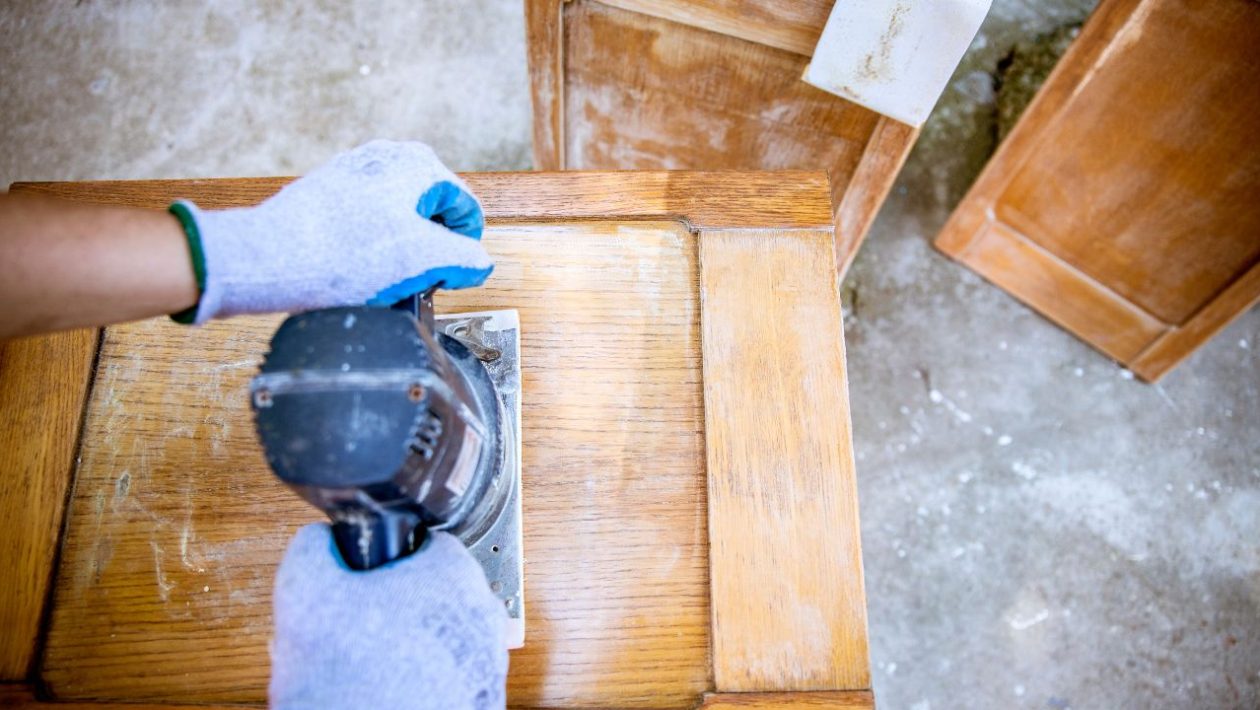Restoring old woodwork requires a combination of skill, knowledge, and patience. It is a meticulous and rewarding endeavor that involves breathing new life into weathered and worn pieces, preserving their history and original beauty.
Every step of the restoration process is crucial, from assessing the condition of the woodwork to carefully selecting the appropriate tools and materials.
In this article, we will explore practical tips and techniques used by professionals in the field, providing you with the confidence and expertise needed to embark on your own restoration project.
Join us as we uncover the secrets of reviving old woodwork and transforming neglected pieces into cherished heirlooms.
Key Takeaways
Restoring old woodwork requires skill, expertise, and a thorough understanding of the process. To successfully restore old woodwork, it’s important to carefully assess the condition of the woodwork, gather the necessary tools and materials, and follow a step-by-step approach.
This involves cleaning the woodwork, repairing any damages, removing old finishes, sanding the surface, and applying a fresh coat of stain or finish. By following these steps, old woodwork can be brought back to its original beauty.
Proper maintenance and care are crucial to preserving these treasured pieces of history for future generations to enjoy.
Assessing the Condition of Old Woodwork
Assessing the condition of old woodwork is an important step in determining the necessary restoration techniques and preserving its historical value. Before starting any restoration project, it is crucial to evaluate the quality of the woodwork and identify any issues that could compromise its integrity.
This assessment involves carefully examining the woodwork for signs of damage, such as rot, insect infestation, or structural weaknesses. It’s also important to check for loose joints or missing pieces to assess the overall stability. Additionally, the moisture content of the wood should be evaluated, as excessive moisture can cause warping or swelling.
https://www.woodworkcenter.com/do-you-paint-woodwork-or-wlls-first-2/
Gathering the Necessary Tools and Materials
To restore old woodwork effectively, it is crucial to gather the necessary tools and materials. Restoring antique furniture requires specialized tools and materials to preserve the natural beauty of the woodwork. Start by acquiring high-quality hand tools such as chisels, planes, and scrapers to remove old finishes and repair any damaged areas.
Power tools like sanders and routers can also be helpful for a faster and smoother restoration process. Additionally, make sure to have a variety of sandpaper grits for proper sanding and a good quality wood stain or finish to enhance the appearance and protect the woodwork.
Lastly, don’t forget to prioritize safety by wearing goggles, masks, and gloves during the restoration process.
Cleaning and Removing Surface Dirt and Grime
What are the best methods and techniques for effectively cleaning and removing surface dirt and grime from old woodwork? When it comes to restoring woodwork, cleaning and removing surface dirt and grime is a crucial step in the process. Here are some recommended techniques for achieving this:
- Dusting: Begin by gently dusting the woodwork with a soft cloth or brush to get rid of loose dirt and debris.
- Vacuuming: Use a soft brush attachment on a vacuum cleaner to eliminate any remaining dust and dirt from the surface and crevices of the woodwork.
- Mild Soap and Water: Combine a small amount of mild soap with warm water and use a soft cloth to gently clean the woodwork. Avoid using harsh cleaners or scrub brushes that can harm the wood.
Repairing Damaged or Loose Joints
One important aspect of restoring old woodwork is the careful repair of damaged or loose joints, which requires skilled craftsmanship and attention to detail.
When it comes to fixing cracked woodwork, the first step is to assess the extent of the damage. This involves examining the joint to determine the cause and severity of the crack. Once the assessment is complete, the next step is to address the issue.
One method is to apply adhesive into the crack and secure the joint with a clamp until the glue sets. In more severe cases, it may be necessary to replace missing pieces. This involves carefully removing the damaged section and creating a new piece that matches the original design. The new piece is then carefully fitted into place and secured using appropriate woodworking techniques.
Stripping and Removing Old Paint or Finish
When it comes to restoring old woodwork, one important step is the careful removal of the old paint or finish. This task can be challenging due to stubborn layers of paint, multiple coats of finish, or intricate designs. To overcome these challenges, woodworkers use different techniques for stripping woodwork:
- Chemical Stripping:
- Apply paint or finish strippers to dissolve and loosen the old coating.
- Use scrapers or brushes to remove the softened paint or finish.
- Repeat the process if needed to completely remove the old coating.
- Heat Stripping:
- Use heat guns or infrared heaters to soften the paint or finish.
- Carefully scrape or sand the softened coating to remove it.
- Ensure proper ventilation and safety precautions when using heat methods.
- Mechanical Stripping:
- Use sandpaper, sanding blocks, or abrasive pads to physically remove the old paint or finish.
- Gradually use finer grits of sandpaper to achieve a smooth surface.
Sanding and Smoothing the Wood Surface
After successfully removing the old paint or finish from the woodwork, the next important step in restoring old woodwork is sanding and smoothing the wood surface.
Sanding is necessary to eliminate any roughness, imperfections, or remnants of the old finish. To achieve a smooth and even surface, it is crucial to sand in the direction of the wood grain. This prevents any potential damage or scratches that may occur when sanding against the grain.
When choosing sandpaper, it is important to select the appropriate grit based on the level of sanding needed. Coarser grits, such as 80 or 100, are ideal for initial sanding to remove most of the old finish, while finer grits, like 220 or 320, are suitable for achieving a polished and smooth surface.
Proper sanding and smoothing will prepare the woodwork for the next steps in the restoration process.
Applying a Fresh Coat of Stain or Finish
To complete the process of restoring the woodwork, the next step is to apply a fresh coat of stain or finish. This will not only enhance the wood’s appearance but also provide protection against further damage. When restoring woodwork without stripping, it is important to select the appropriate stain or finish that complements the existing color and texture of the wood.
Here are some helpful tips for choosing the right stain or finish:
- Consider the type of wood: Different types of wood require different types of stains or finishes. Make sure to choose a product that is compatible with the specific wood you are working with.
- Test the product: Before applying the stain or finish to the entire woodwork, test it on a small, inconspicuous area. This will allow you to determine if the color and finish meet your expectations.
- Follow the instructions provided by the manufacturer: Each stain or finish product comes with specific application instructions. It is crucial to carefully follow these instructions to achieve the desired results and ensure proper adhesion and durability.
Maintaining and Caring for Restored Woodwork
Proper care and maintenance are vital for preserving and prolonging the life of restored woodwork. Once you have completed the restoration, it is important to establish a regular maintenance routine to prevent any future damage.
Regular cleaning is a key aspect of maintenance. Dust and dirt can accumulate on the surface of the woodwork, leading to scratches and a dull appearance. To prevent this, use a soft cloth or brush to regularly remove dust and debris.
Additionally, it is advisable to avoid placing objects directly on the woodwork to prevent scratches and dents. Using coasters, placemats, and felt pads under objects can provide protection.
Furthermore, maintaining a stable humidity level in the environment is crucial. Fluctuations in humidity can cause the wood to shrink or expand, leading to cracks or warping.
Frequently Asked Questions
How Long Does It Typically Take to Restore Old Woodwork in a Woodworking Workshop?
The time it takes to restore old woodwork in a woodworking workshop can vary depending on the condition of the wood and the extent of restoration required. Techniques such as sanding, refinishing, and repairing damaged areas may be used. It is important to consider the audience’s familiarity and knowledge level, use clear language, avoid clichés and overused words, and provide context to explain the significance of the restoration process. Transition words should be used thoughtfully to maintain a natural flow, and active voice is preferred for clarity. Hyperbole should be minimized, and claims should be supported with evidence. Specific examples and product recommendations can be included as needed, as long as they are rewritten in original words. Spelling and grammar errors should be corrected, and plagiarism should be checked to ensure unique content. A conversational writing style that mimics human writing should be employed, and necessary words can be bolded. The writing style should be persuasive and relaxed, while avoiding words that are disliked by Google for better indexing. The content should be based on the latest data as of October 12, 2023, and comprehensive paragraphs with rich details should be used. Subheadings with keyword-rich titles can be utilized for clarity, and a custom quote can be included in the article.
Are There Any Specific Safety Precautions That Should Be Taken When Restoring Old Woodwork?
When restoring old woodwork, it is important to prioritize safety precautions. This involves wearing protective gear like goggles, gloves, and a mask. It is crucial to use appropriate tools and equipment such as respirators and dust collectors to create a safe working environment.
Can I Use Regular Household Cleaning Products to Clean and Remove Surface Dirt and Grime From Old Woodwork?
Regular household cleaning products may not be the best choice for cleaning and removing surface dirt and grime from old woodwork. It is advisable to use specialized wood cleaners or alternative methods for safe and effective results.
What Are the Most Common Types of Damage or Loose Joints Found in Old Woodwork?
Damage to old woodwork can occur due to various reasons, including exposure to moisture, insect infestation, and the natural effects of aging. Repairing loose joints in old woodwork may require techniques such as applying glue, using clamps, or replacing damaged parts.
Are There Any Alternative Methods to Stripping and Removing Old Paint or Finish From Woodwork?
There are several alternative methods available for stripping and removing old paint or finish from woodwork. These methods include the use of chemical strippers, heat guns, or sanding. It is important to follow proper techniques to effectively remove the old paint without causing any damage to the wood. By using these alternative methods, you can achieve successful results in rejuvenating your woodwork.
Conclusion
Restoring old woodwork is a delicate art that requires skill, expertise, and a thorough understanding of the process. To successfully restore old woodwork, it is important to carefully assess the condition of the woodwork, gather the necessary tools and materials, and follow a step-by-step approach.
This includes cleaning, repairing any damages, stripping old finishes, sanding the surface, and finally applying a fresh coat of stain or finish. By taking these careful steps, old woodwork can be brought back to its original beauty.
It is crucial to provide proper maintenance and care to ensure that these treasured pieces of history can be preserved for future generations to enjoy.





